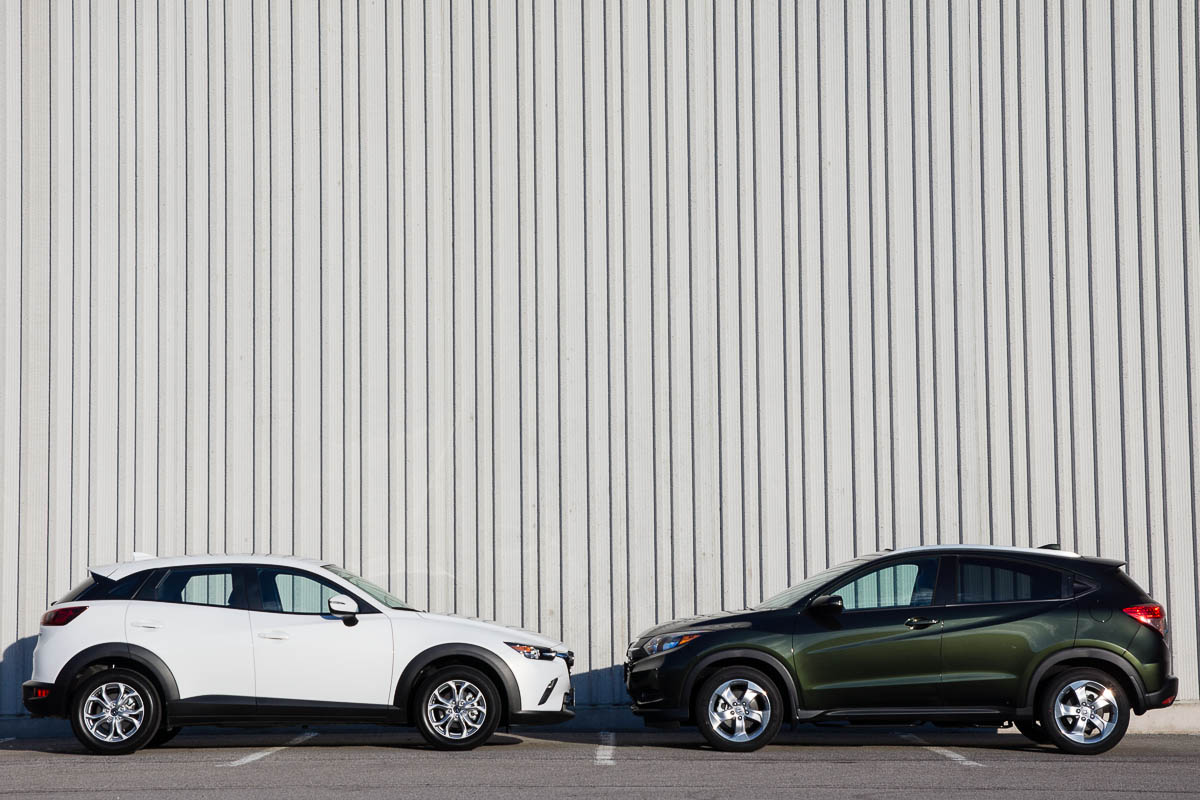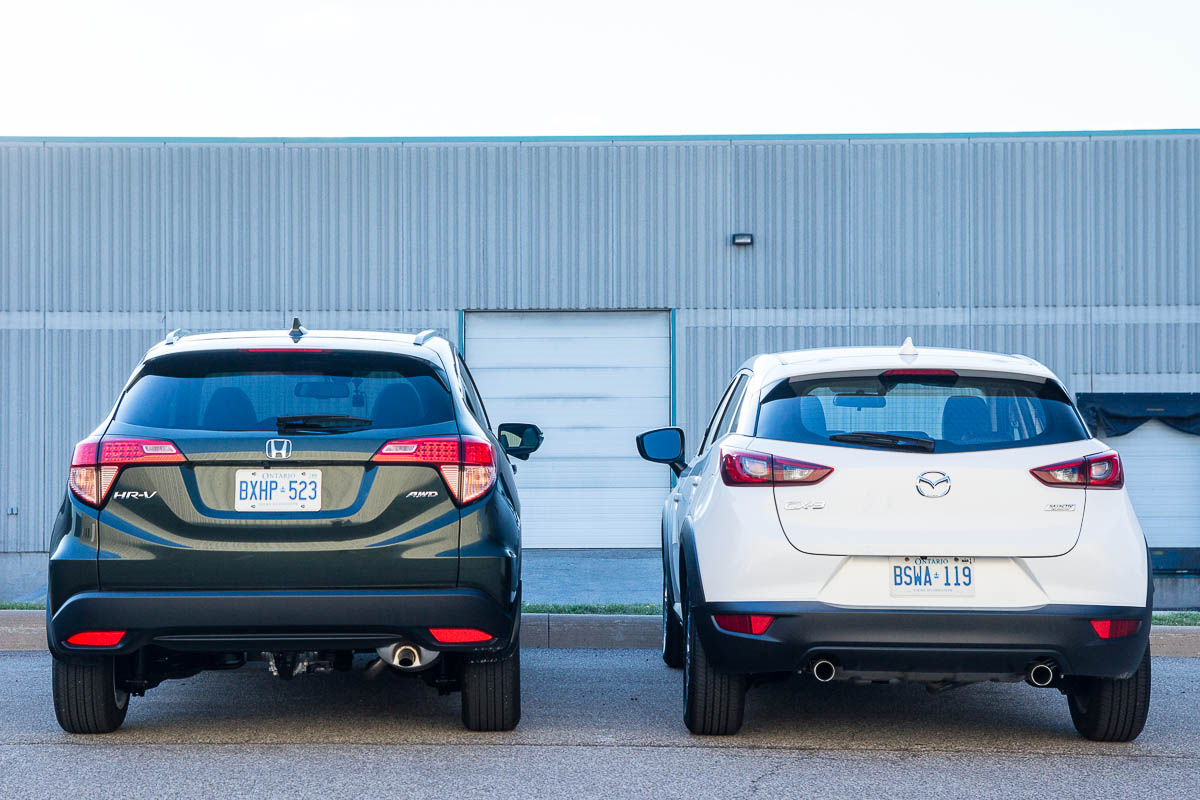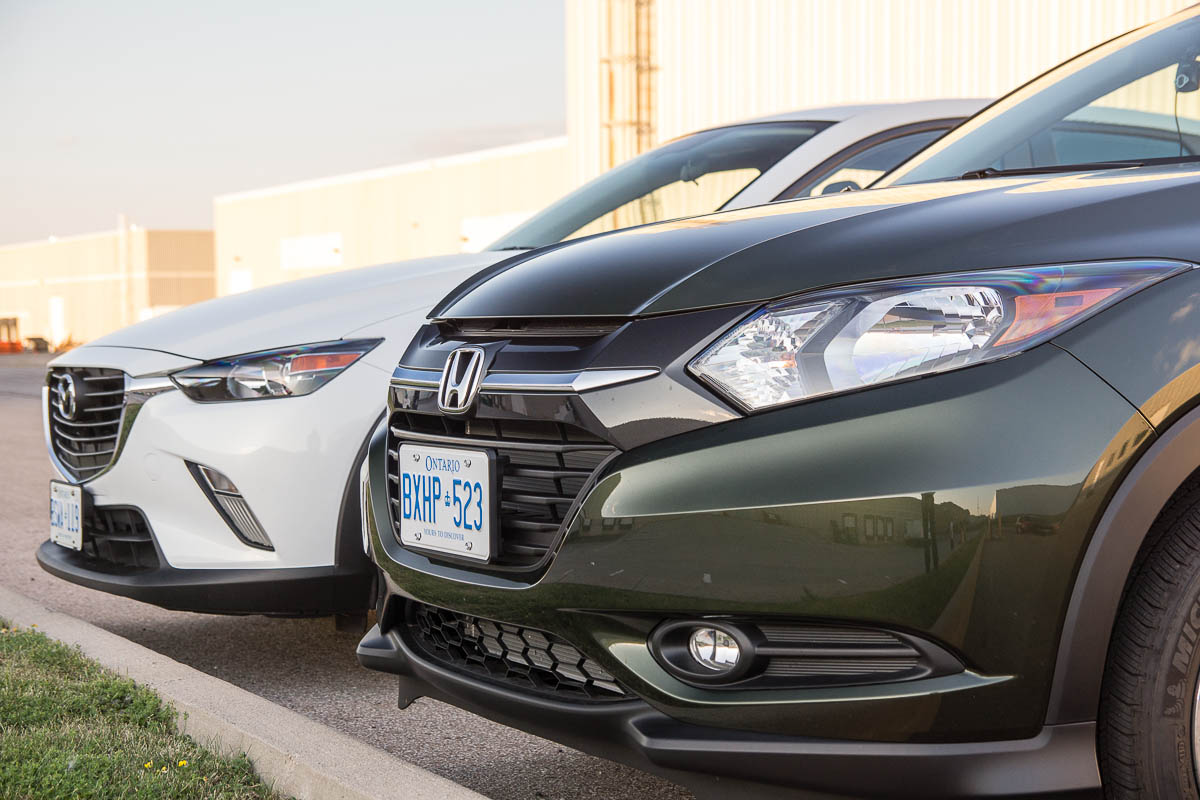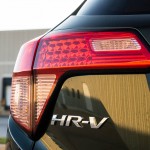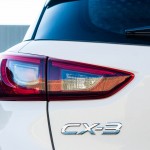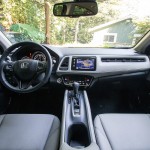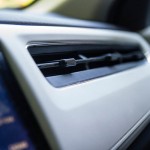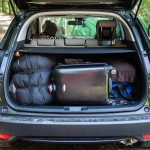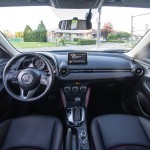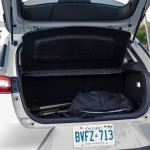Model year 2016 has big things in store for the compact CUV market, which has really taken off and seen an exponential amount of growth over the last couple of years. This means everyone is tooling up to put together the latest and greatest compact CUV; ultimately this means more choice, better vehicles and more aggressive pricing for consumers. This week I took a close look at two brand new offerings for 2016: the Mazda CX-3 and the Honda HR-V. Each manufacturer took a dramatically different approach to their new baby CUVs and I was anxious to find out which would resonate the strongest with me.
The difference in philosophy between these two vehicles is immediately apparent the moment you look at the two of them side by side. The Mazda leverages the brand’s now well-established and received KODO-Design, which focuses on the theme of motion. It is sculpted, flowing and has excellent proportions that give the CX-3 a very well-rounded and sporty look; while rubberized cladding around the wheel wells and rocker panels add a rugged personality.
On the flip side, the HR-V is all about function over form and its shape reflects that. It is taller, wider and more squared off than the Mazda to help maximize interior capacity. A strong diagonal body line and cleverly hidden rear door handles alludes to the look of a sporty coupe. The Honda’s proportions are a little off for my tastes, and the large relatively flat side panels don’t blend well with its otherwise sporty appearance. Interestingly, the Honda’s fuel tank is positioned underneath the driver’s seat area and a tubular skid plate is visible on the driver’s side of the car to protect the tank from damage. For me, the Mazda’s cohesive flowing lines and overall sporty appearance win out over the Honda’s chunkier more utilitarian style.
Inside these two CUVs is where Honda’s more functional exterior design really begins to show its advantages. The interior space inside the HR-V is simply massive; folding the rear seats down reveals a class leading cargo area that will easily handle anything you could reasonably want it to. The Honda’s low flat floor also means that loading- as well as entering and exiting the vehicle- are an absolute breeze. It’s not all just about utility though; the HR-V utilizes a selection of upscale-looking soft touch materials and displays better overall fit and finish inside compared to the Mazda.
The Mazda’s sporty good looks mean that the designers have had to sacrifice some utility. Both the rear hatch opening and cargo area itself are notably smaller than that of the Honda. Passenger room in both CUVs is adequate, but the Mazda’s smaller exterior dimensions mean it is slightly more cramped in both the front and rear seats. What I did love about the Mazda’s interior is the sporty driver-centric layout, the very nicely detailed gauge cluster, controls that are all where they should be and the neat red and aluminum accents throughout. The Mazda’s interior is just about the driver, while the Honda’s interior is about the driver, his passengers and all their stuff. In this segment, for the majority of shoppers, the Honda is the clear winner.
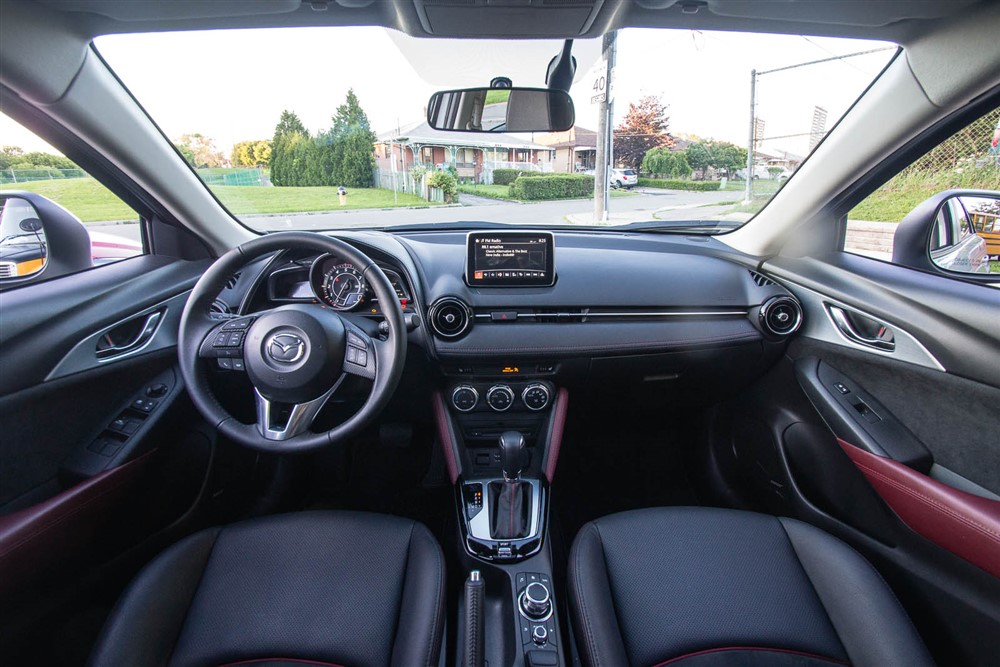
Now, when it comes to equipment, it’s a little difficult to directly compare our test vehicles. The CX-3 tester is a mid-range GS model with front-wheel drive and an MSRP of $26,419. That gets you the Leatherette heated seats, a power moonroof, rear view camera, 7” touchscreen and 16” alloy rims. That’s almost everything I would want in a small CUV with the exception of automatic climate control and satellite radio. Our HR-V tester is a loaded all-wheel drive EX-L and does include those missing features, along with navigation and Honda’s genius Lane Watch system.
The Honda came out to just under $32,000; however when spending some time on Honda’s website, I was able to build an HR-V very similarly equipped to our CX-3 tester for about a $1000 less, despite the Honda’s overall higher starting price. Both of these baby CUVs offer a lot of value for your money- and both come very well-equipped- whether you’re shopping at the entry level or the top-trim models. It’s worth noting that the infotainment system in the Mazda is much more responsive, aesthetically pleasing and easier to navigate than the one found in the Honda, which is very blue and due to be revamped. Alternatively, Honda’s LaneWatch system available in the HR-V is a class exclusive and a great safety feature, especially for a young or new driver.
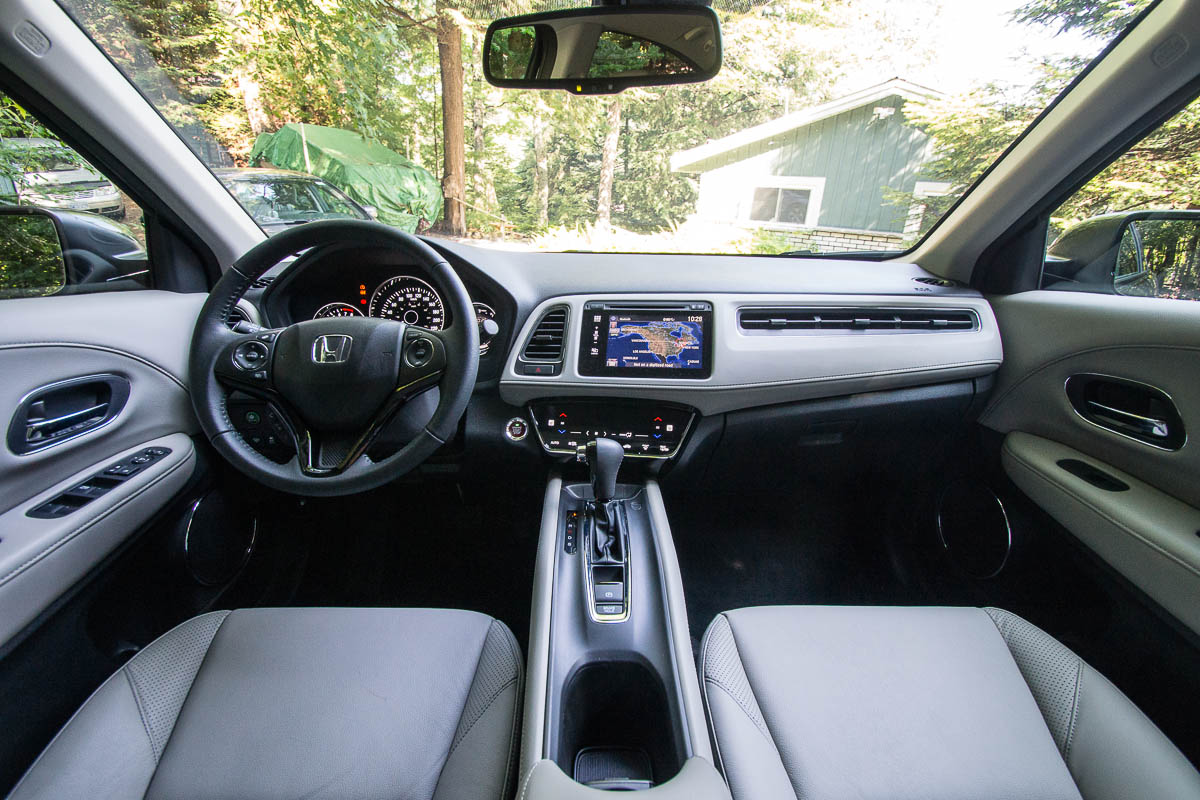
Our enthusiast readers will surely care more about how these CUVs drive than the responsiveness of the touchscreen, so I took both CUVs on some familiar roads to get a feel for them. First up was the Honda, offering a very relaxing and agreeable driving experience. The steering is light and responsive; however, there is little feedback and the ride is much more comfortable than it is sporty. The Honda’s 1.8L, 141 horsepower 4-cylinder, mated up to Honda’s CVT transmission, takes a while to bring the little CUV up to speed, especially with the added weight of the all-wheel drive system in our tester. The CVT does lend itself well to highway cruising, keeping the rpms low and noise levels down at higher speeds. This makes the HR-V a very competent and comfortable commuter both on and off the highway.
The driving experience in the Mazda is dramatically different than that of the Honda. It is agile, energetic and much peppier thanks to a rev-happy SKYACTIV-G 2.0L 4-cylinder, which despite being rated at a mere 146 horsepower squeezes every last bit of excitement from that little engine. The steering in the CX-3 is not only responsive but offers enough feedback to lend the driver the needed confidence to carve through corners with a grin. Ride quality does suffer in the name of fun and the Mazda is both noisier and a little harsher to ride in than the Honda.
The Mazda’s 6-speed automatic, with sport mode, performs flawlessly with quick and crisp downshifting to help make light work of passing at higher speeds. The better CUV really comes down to personal preference; the Honda is a more refined and comfortable ride, while the Mazda offers a much better connection to the road and the same enthusiasm for driving that we’ve come to expect from a Mazda product. Personally, in a smaller CUV such as these, I’d opt for the extra bit of performance and excitement of the Mazda over the compliant Honda.
One of the big reasons for the recent growth in this segment is the increased importance of fuel economy, and both of these CUVs aim to please with very amicable fuel economy numbers. In my typical rush hour mixed commute, I averaged 6.8L/100km in the CX-3 and 8.0L/100km in the HR-V. These numbers are right in line with the published ratings for these two. I attribute the difference between my two testers to be largely based on the fact that the HR-V is equipped with all-wheel drive, while my particular CX-3 benefits from the weight savings of being only front-wheel drive.
I really enjoyed the versatility and economy of both of these little newcomers to the CUV segment. The truth is- they are both very competitive vehicles that will no doubt earn their own loyal followings. That said, if I was in the market for a CUV it would be a very tough choice between HR-V’s extra utility, comfort and refinement versus the CX-3’s styling, driver-centric cockpit and the much more engaging driving dynamics. As an enthusiast, I enjoyed myself more while behind the wheel of the CX-3; I’m also definitely partial to its styling, so it would be my choice.


